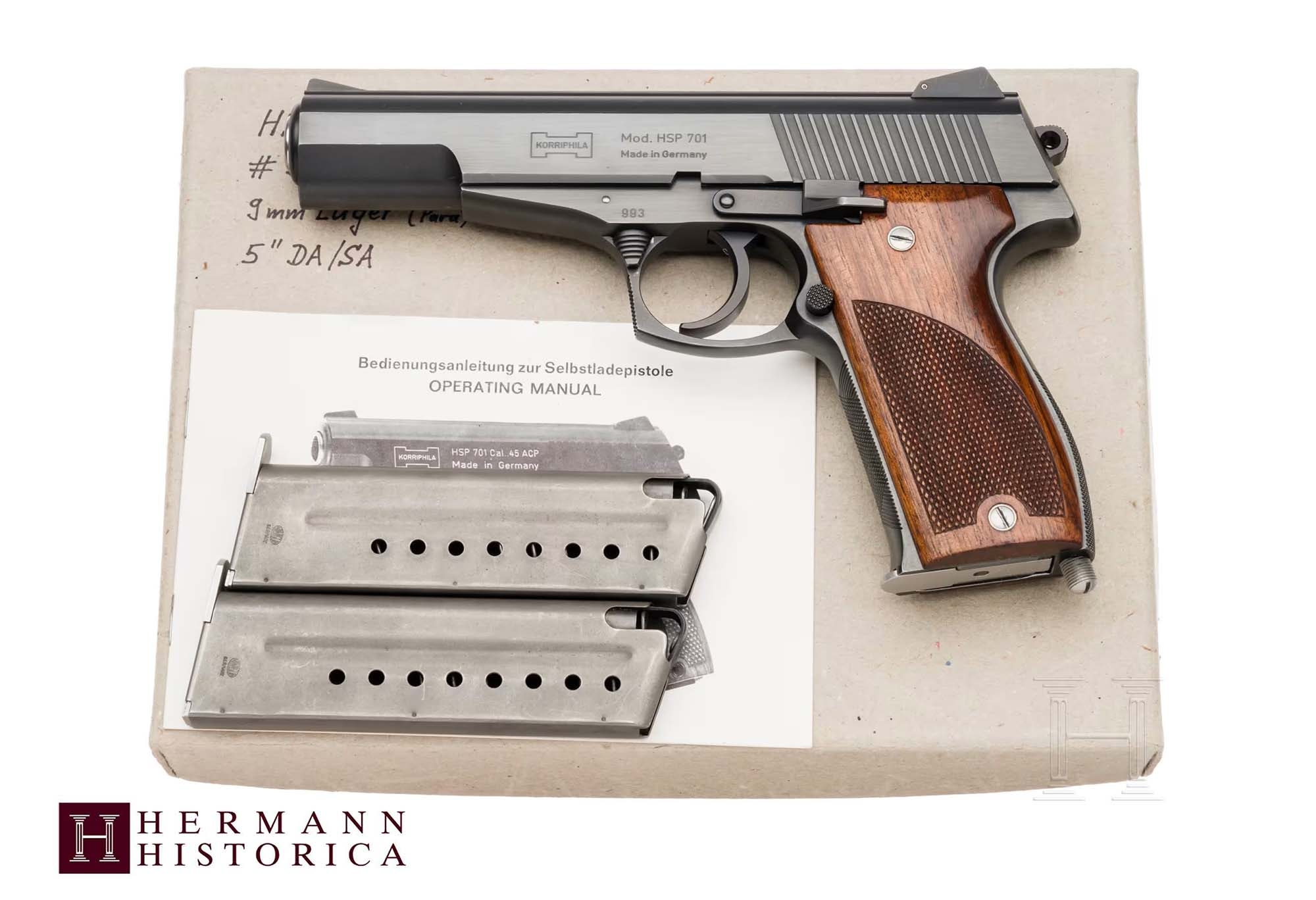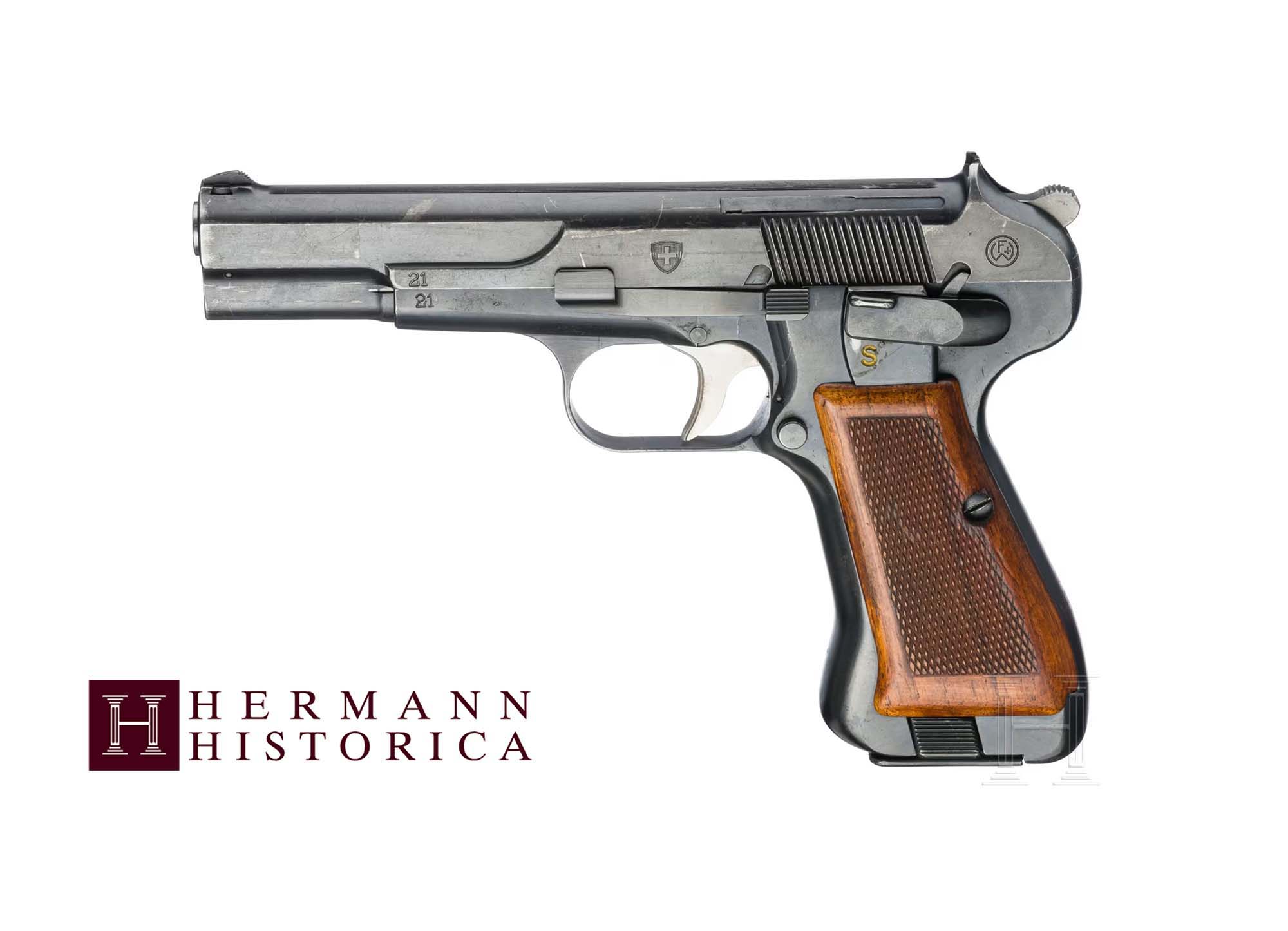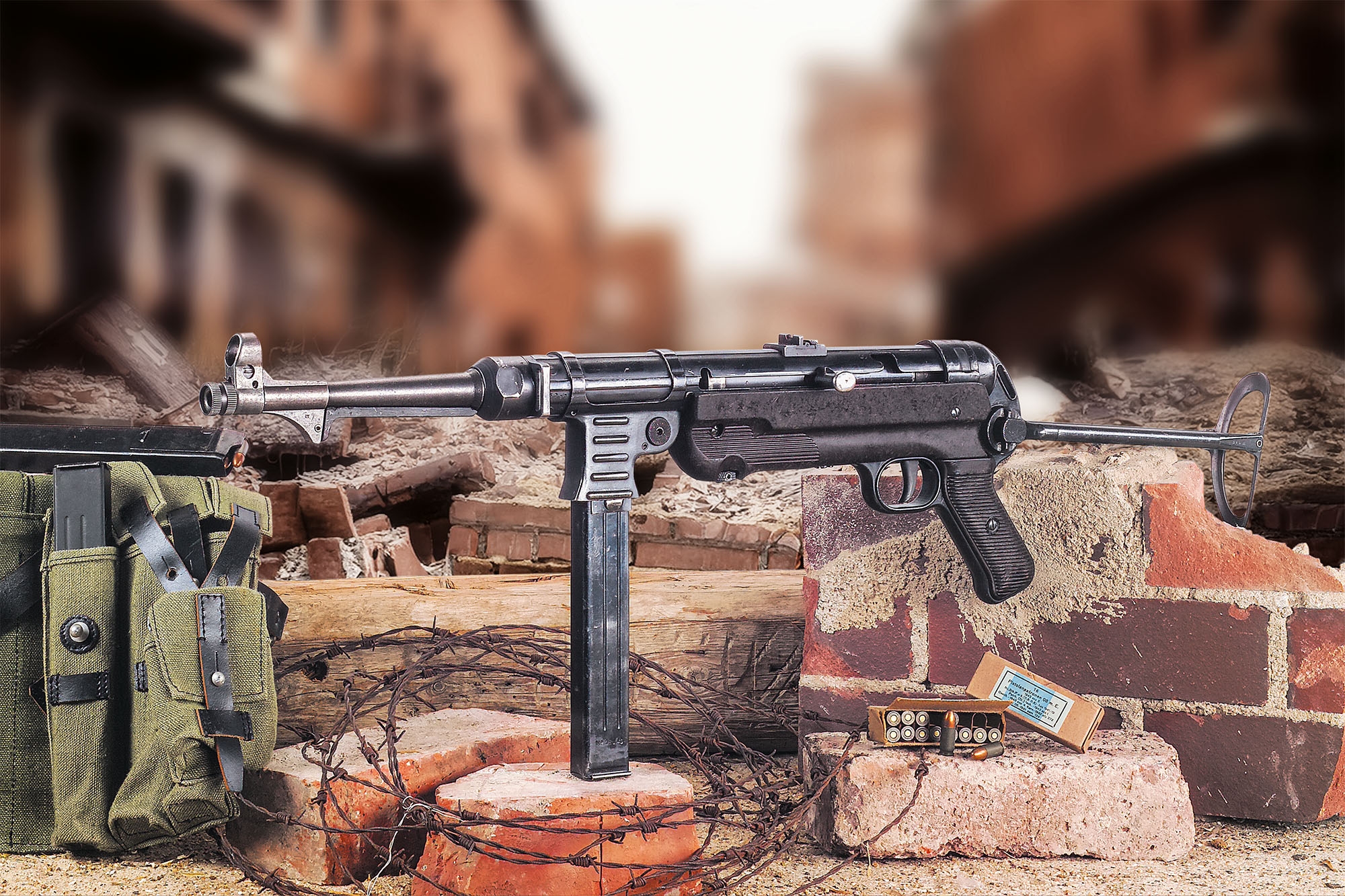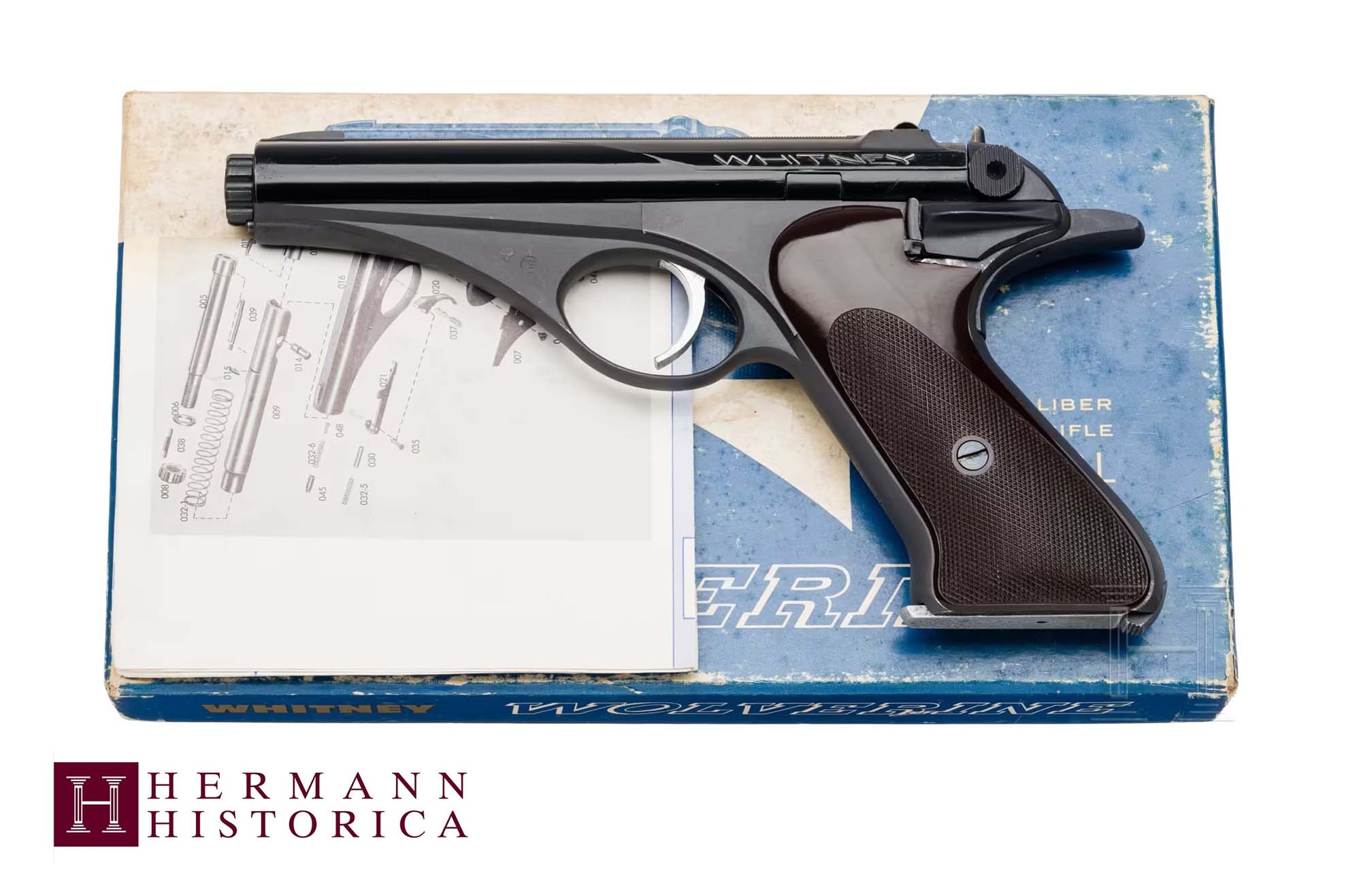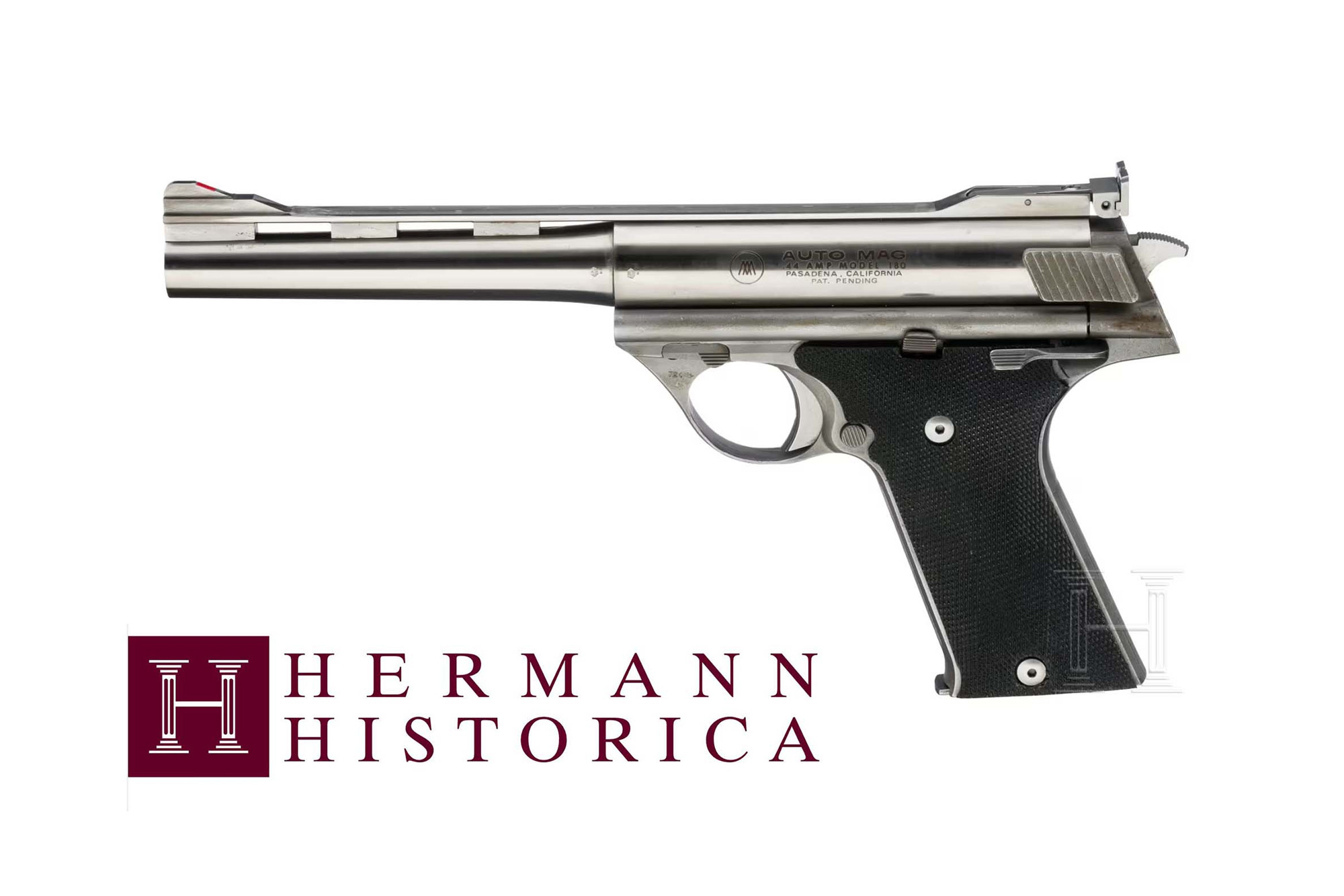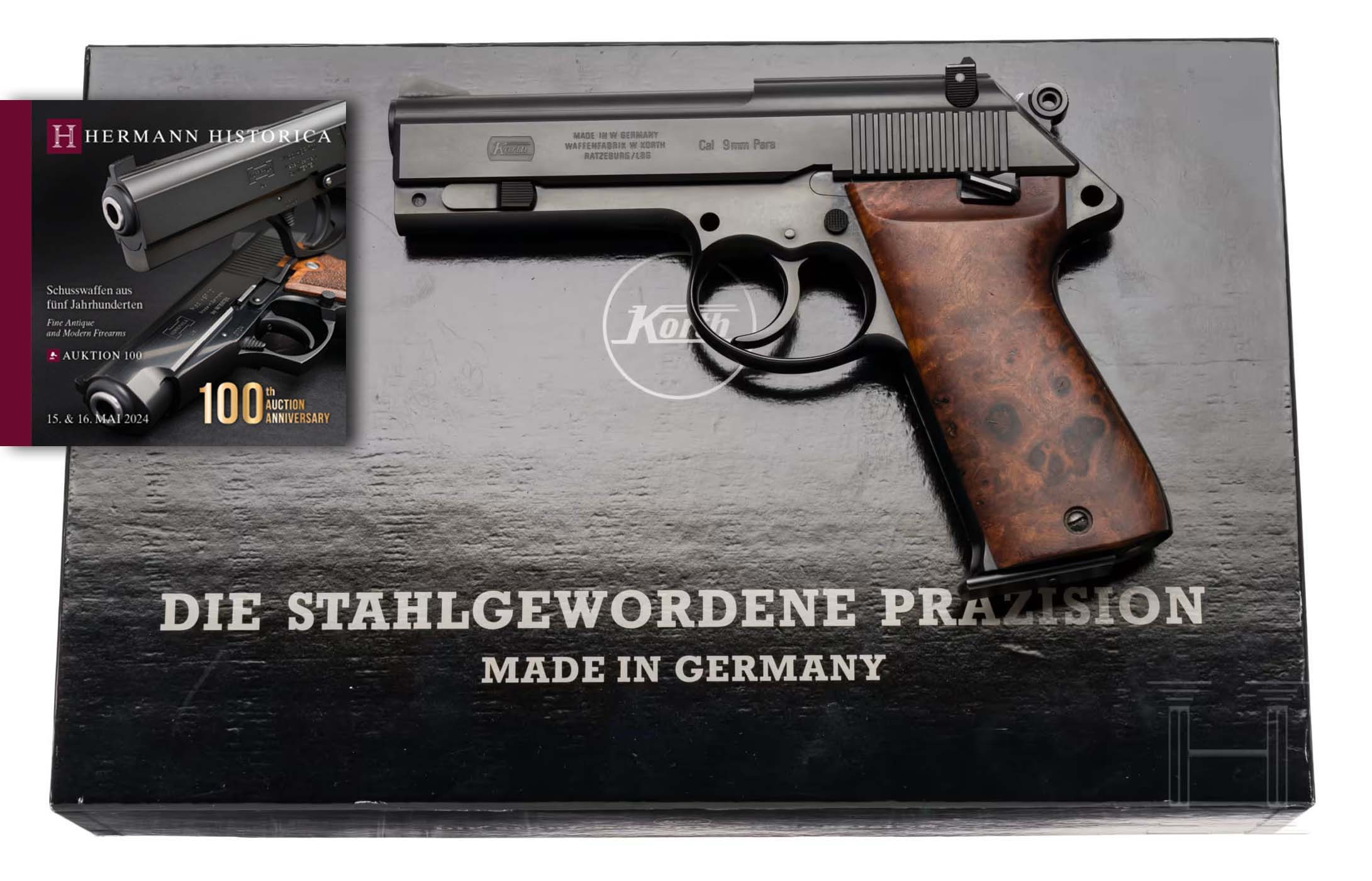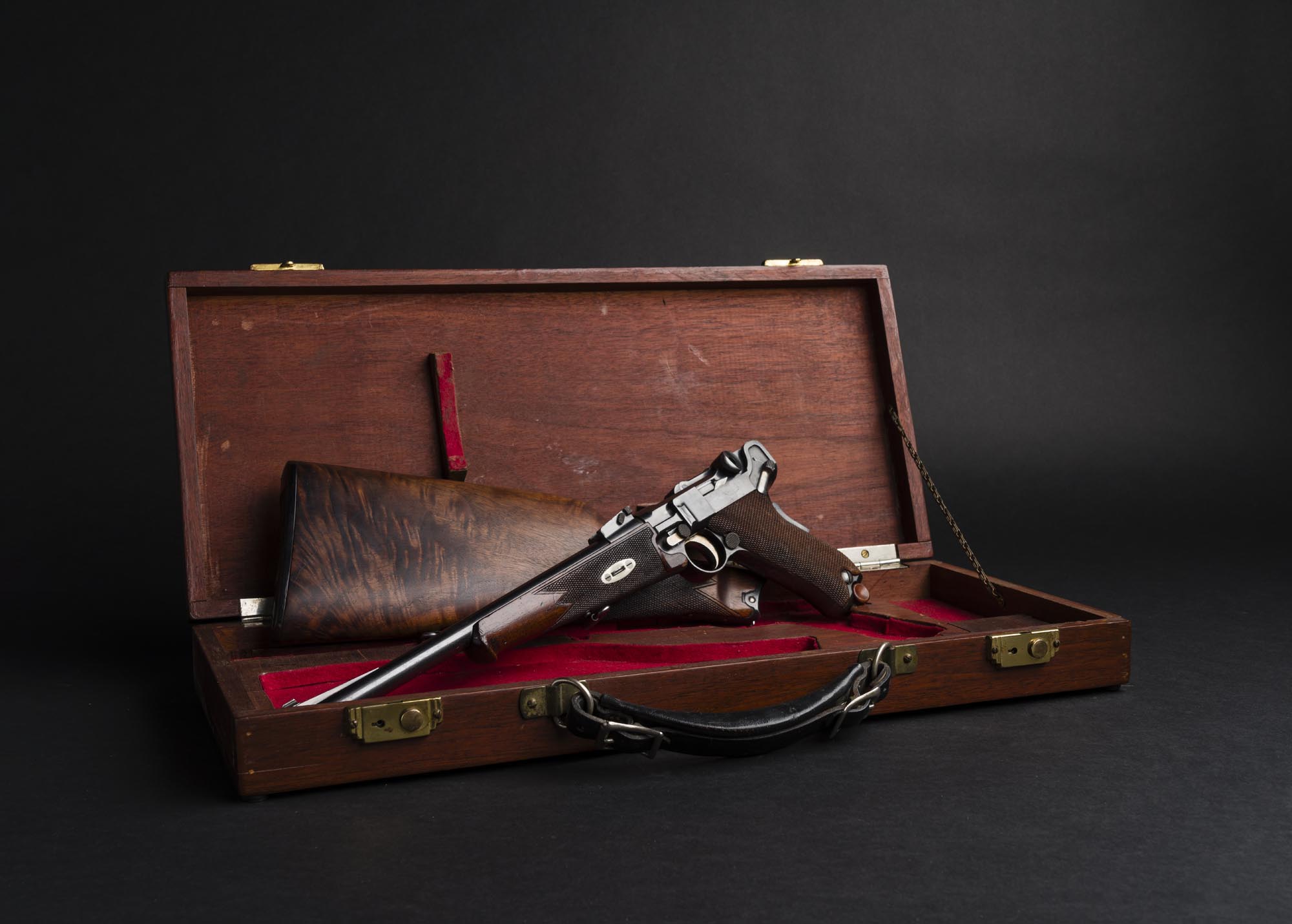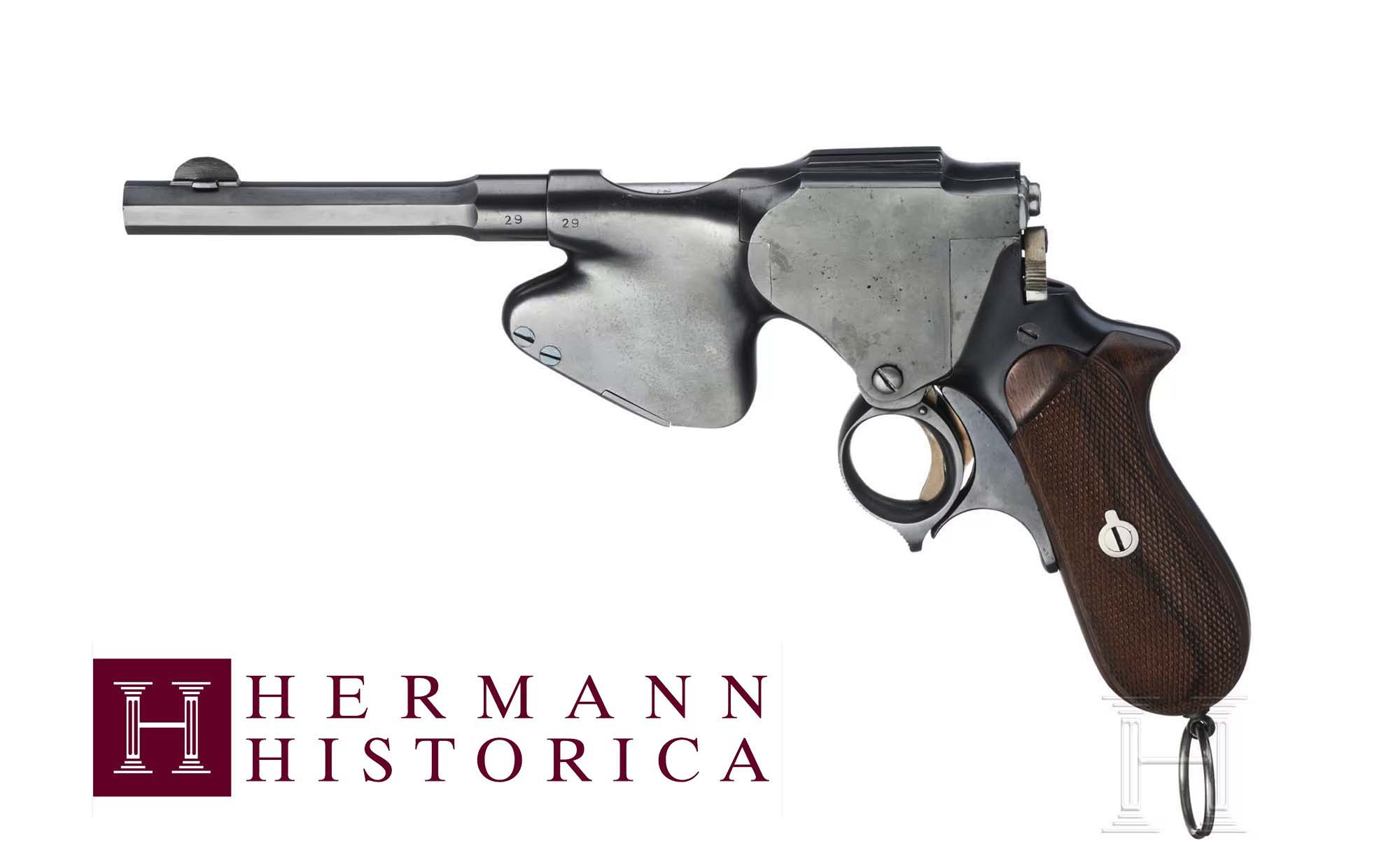It is probably one of the really rare opportunities: the catalogue for Hermann Historica's 100th auction contains various gun models from the German manufacturer Heckler & Koch, whose histories are almost directly interwoven. Two models that could hardly be more different from a technical point of view and that are connected in an almost tragic way. The success of one model ended the further development of the other.
The country needs new guns: a pistol for the police
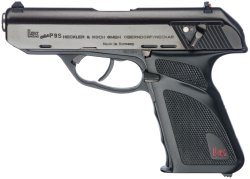
Since the late 1960s, German police officers had been feeling dissatisfied. The increasing willingness of criminals to use violence and the burgeoning terrorism revealed shortcomings in the equipment. An extensive search ultimately resulted in a specification for a new police gun. The search was for a pistol in 9x19mm caliber with compact dimensions, reliable function and handling, without a manual safety, ergonomically designed and durable. Because the tender suggested that the gun would be introduced to police forces throughout Germany, Heckler & Koch in Oberndorf am Neckar was interested. With the P9S model, the company already had an exceptional pistol in its catalog, which was also used in small numbers in law enforcement. The Bavarian police used the modern pistol, as did the GSG 9 special unit of the German Federal Police. The P9S was launched in 1970, a direct development of the P9 introduced in 1968, only with a double-action trigger and offering unusual technical features at the time. It used the roller-delayed blowback system already familiar from the G3 rifle and the MP5 submachine gun. It had an internal hammer that could be manually cocked via a cocking lever on the side and also decocked again in combination with the trigger. It was manufactured using the latest sheet metal stamping technology and featured a polymer trigger guard. The gun barrel had a polygonal profile and the manufacturer was so convinced of its design that they described it in adverts as "The best pistol in the world". In its previous form, however, it did not meet the new requirements for a police pistol. Too large, with a manual safety and ergonomic weaknesses when decocking. Until now, the side-mounted cocking lever had to be pressed and then the trigger pulled. With early guns, this was only possible with the safety off. But even after the pistol had been redesigned so that it could also be decocked when the safety was engaged, the operation of the trigger remained a weak point in the design, as operating errors occurred from time to time – including unintentional discharges.
Heckler & Koch: the gentle evolution to the P9S Police Combat
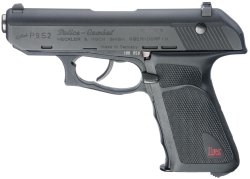
The first item on the agenda was the revision of the safety and cocking lever concept. Instead of a manual safety the pistol, now known as the P9S Police Combat, only has a bolt for fastening the control piece in the slide. The slide serrations are also consistently extended up to this bolt – the recess in which the safety catch could otherwise be swivelled is missing. Just as significant as the omission of the manual safety is the fact that the cocking lever now also functions as a decocking lever – without the need to pull the trigger. The automatic firing pin safety can only be seen when the gun is disassembled. The model was never produced in series. According to the relevant literature, only eight were made, of which only three have survived. Our pictures show the gun with the serial number 100 058, as lot 1187 in the 100th auction of the Hermann Historica auction house.
Made to measure: HK P9S Police Combat - in a short version
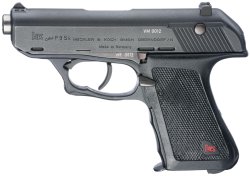
A short version was then derived from the P9S Police Combat, which was based on the so-called specifications with regard to the overall length of the gun and its maximum permissible height. Technically, it also features the revised safety and cocking lever concept. There is no longer a manual safety, but instead an automatic firing pin safety. The height of the grip was reduced slightly, but the magazine floorplate was designed as a slightly bevelled finger rest at the front. The P9S Kurz ("Short") too was only made for testing purposes. Such a pistol can also be found in the Hermann Historica auction. It is the piece with serial number VM 012, lot 1188, and development did not end there. While the P9S Kurz still shows the slide contour of the standard P9S, an attempt was initially made to compensate for the shorter sight radius by moving the sights back. The result was called a "backpack sight", but it remained an experiment. In the end, Heckler & Koch reworked the entire slide and gave it a more angular shape. Only a few examples of the gun, now called the P9 Kurz, were manufactured. From then on, the focus was on the development of a new firearm. The established P9S, on the other hand, continued to be offered in its familiar form.
The revolution from HK: the gas-delayed blowback system and the striker-fired action with a cocking handle
In the meantime, Heckler & Koch had also orientated itself in a different direction. Not so much the idea of adapting an existing gun to the specific requirements of the German police, but rather tailoring a gun precisely to the specifications. Two design elements that were already familiar but rarely used in gunmaking were chosen and combined to create an unusual pistol: the gas-delayed blowback system and the striker-fired action with a cocking handle. Both were initially trialled in modified Heckler & Koch pistols. The gas-delayed system in a VP70, which actually uses a blowback system and a spring buffer, the cocking handle on an HK4, where it was attached to the back of the grip and quickly led to the realisation that it would be better attached to the front of the grip frame.
The nameless child: how it got the name PSP
It may come as a surprise, but Heckler & Koch had not initially given any thought to the name of the new pistol. Previous model names referred to special design features. The name of the first H&K pistol HK4, for example, was derived from the possibility of firing four calibers from one basic design. P9 means pistol with 9-round magazine, P9S means double-action pistol (the "S" stands for the German Spannabzug, double action trigger). VP70 is a combination of Vollautomatische Pistole (fully automatic pistol) and the year of market launch, namely 1970. When a Heckler & Koch employee presented the gun at the Lübeck Federal Border Police Academy – where the trials to select a new police pistol were taking place – a discussion between the officer conducting the trials, Wolfgang Pietzner, and the H&K company representative ultimately led to the well-known model designation. Pietzner insisted on a name to distinguish the new model from the P9S already being trialled. After the suggestion that the new gun should simply be called a police pistol, which Pietzner rejected with reference to a model of the same name from another manufacturer, the somewhat unwieldy idea of a Polizei-Einsatz-Pistole ("Police Operation Pistol") followed, and from this the abbreviation PEP was derived. Wolfgang Pietzner corrected this to "why don't you just call it a police self-loading pistol, which would then result in the abbreviation PSP?". It was a suggestion that would stand the test of time.
A "hot filthy girl": the HK PSP
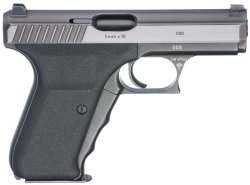
The PSP pistol performed well right from the start, although it did exhibit two shortcomings that were to remain with it throughout its evolution despite intensive efforts: the gun's enormous carbon build-up and the strong heating-up. The combustion residue quickly led to malfunctions in the early prototypes. And they found their way onto the shooter's hand and face during initial testing due to the excessive slide opening velocity. As a result, the Border Police Academy cancelled the trials. Heckler & Koch looked for a solution to make the gun more reliable and received a pioneering idea from an external consultant. The pistol with serial number 008, offered in the Hermann Historica auction with the lot number 1169, initially served as a model for the manufacturer's first advertising and press photos. For example, number 008 can also be seen in an article published in May 1977 by a well-known German gun magazine. However, the test gun that editor Klaus Schinmeyer tried out for his article, which was only in the editorial office for a few days, was the gun with the serial number 012. The photo model with the number 008 ended up in the hands of firearm expert Hans-Bert Lockhoven, who gave it the slightly disrespectful name "squeeze gun" due to its unusual cocking lever. He suggested adding wiper rings to the gas piston in addition to the sealing rings, which would also transport combustion residue out of the gas cylinder with every slide movement. Today, the gun with the serial number 008 shows the gas piston with sealing and wiper rings modified according to his suggestion.
Heckler & Koch PSP, trigger and cocking lever: dangerous mistake, dangerous solution
The PSP of the second test series in Lübeck could only be fired if the shooter operated it correctly. In Heckler & Koch's imagination, this meant fully depressing the cocking lever and only then pulling the trigger. Surprisingly, this approach also found favour with the officers deployed to test the guns. First cock, then pull the trigger. The fact that the PSP with its cocking lever did not, strictly speaking, fulfil the specifications requirements, which stipulated that the gun should be fired by pulling the trigger without any further manipulation, was readily accepted. People were happy that established gun manufacturers were ready to develop new firearms at all. In the course of further trials, however, things turned out as they had to. An incorrect operation of the PSP revealed the weakness of the design. If the trigger is pulled before the cocking handle is squeezed, the gun can no longer be cocked. It is then effectively incapable of firing. A circumstance that could not be accepted. The manufacturer's solution was radical. A small metal bar on the rocker arm, which prevents the cocking lever from being squeezed when the trigger has already been moved to the rear, was removed. The gun has always fired since then. Regardless of whether you first squeeze the cocking handle and then pull the trigger, or first pull the trigger and then squeeze the cocking handle, or both at the same time. The same also applied to the gun of the first test series. However, there were complaints about accidental discharges that occured when the trigger was still pulled after firing, the cocking lever was left slightly forward and then squeezed again.
Details, details, details: changes in the development of the PSP
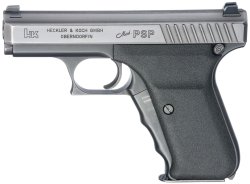
During the development of the PSP, various details on the gun were changed in order to implement the ideas and wishes of the customers and make the gun better. This is particularly evident in the grip panels. Very early PSPs – and the PSP for sale with the serial number 008 still has them today – have finely stippled plastic grips. Later PSPs, on the other hand, were fitted with chekered plastic grips. Some guns today also have wooden grips – usually with a stippled surface. The very first guns had fine slide serrations, which gave way to coarser serrations after just a few pieces. At least up to and including serial number 013, the pistol had a guilloche slide top. Later guns have a slide top with longitudinal serrations. At least up to serial number 013, the nose on the trigger guard had a few horizontal serrations; later guns have vertical serrations on the front of the trigger guard. The shape and surface structure of the cocking lever were also changed several times. On the first pistols, the cocking lever was still straight and had an engraved pattern. With finger grooves and slightly roughened on the 013, much rougher on the 033 and again rougher on guns with higher serial numbers. Vertical grooves in the finger recesses of the cocking lever, which appear to have been added later, can be found in various places.
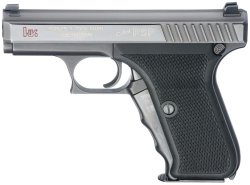
The slide stop, which in early guns can only be activated by an empty magazine, underwent a design change. It was redesigned so that it could also be operated manually, lying between the grip panel and the frame, which was then also modified. Various PSPs were probably retrofitted with the externally operated slide stop. For example, the aforementioned gun with the serial number 008, which now also shows the vertical grooves of later guns on the front of the trigger guard. The trigger blade, which can have different curvatures and which at the breakpoint touches the trigger guard on some guns but not on others, was also modified. The tritium illuminated sights remained a temporary feature. Due to the need for radiation protection, most PSPs were fitted with sights featuring three white plastic dots. One change to only a small number of PSPs is the slot between the slide and the grip frame. On these guns, the guides moulded into the muzzle ring, into which the edges of the frame engage, were welded. Since the slide no longer fits on the frame, the side walls of the latter in front of the trigger were reduced in height and bevelled. As a result, when the slide is fitted, there is now a narrow opening on the sides of these guns from which heat and combustion residues can escape. However, this was probably only a side effect. The real cause of the welding of the slide guides in the muzzle ring was the formation of cracks. As a result, all parts of the pistol were reworked and its dimensions changed, ultimately resulting in a new gun which, on closer inspection, differs from previous versions.
On the way to the P7: between HK PSP and pre-series P7
These revised guns no longer bear the model designation PSP on the left side of the slide. They are practically identical in construction to the very early P7s, at most bearing the model designation PSP on the grips. If a distinction is made between the PSP and the pre-production P7, then serial number 239 is the last original PSP and serial number 240 is the first pre-production P7. Both guns can also be found in the 100th auction and have the lot numbers 1168 and 1170. So are there really only 239 of the original PSP? That is doubtful. The specialist author Manfred Kersten once wrote that there was another series of 11 pistols with six-digit serial numbers, but that these were attributed to the P7. Since a gun from this series has since been available for inspection and it is undoubtedly an original PSP, 250 pieces would be more likely. The pistols were used in a variety of ways to advertise the unusual design. There was a demonstration team at Heckler & Koch who presented the advantages of the "quick gun".
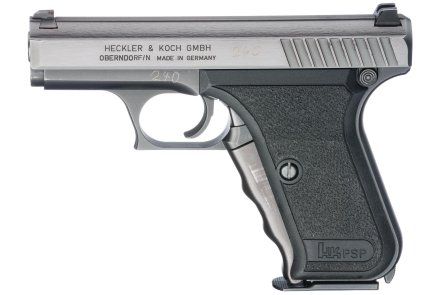
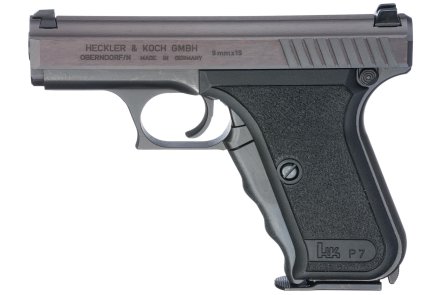
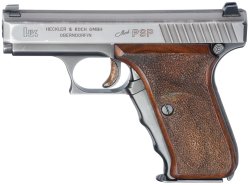
One of these team guns, the piece with the serial number 053, can also be found in the current Hermann Historica auction. It is lot number 1166, an offer with two slides, one of them with sporting sights. And there were special advertising and marketing measures. A sheet designed as a "wanted" poster to search for the ideal police pistol advertised the PSP. Incidentally, this is also part of the auction – lot number 1936. Heckler & Koch also offered a PSP as the first prize in a competition between German special units. The best individual shooter received a voucher for a PSP – to be redeemed on presentation of a purchase authorisation. The PSP with the serial number 132 – packed in a neat jewellery box and with embossed wooden grips – then found its way to Franconia. The winner's team, the SEK from Nuremberg, on the other hand, found their way to Oberndorf in order to familiarise themselves with the advantages of the new gun directly from the manufacturer, as documented by a letter. Marketing as it was imagined in the late 1970s. However, a slogan used for adverts would prove to be a warning sign years later: "This is the new draw and shoot pistol!".
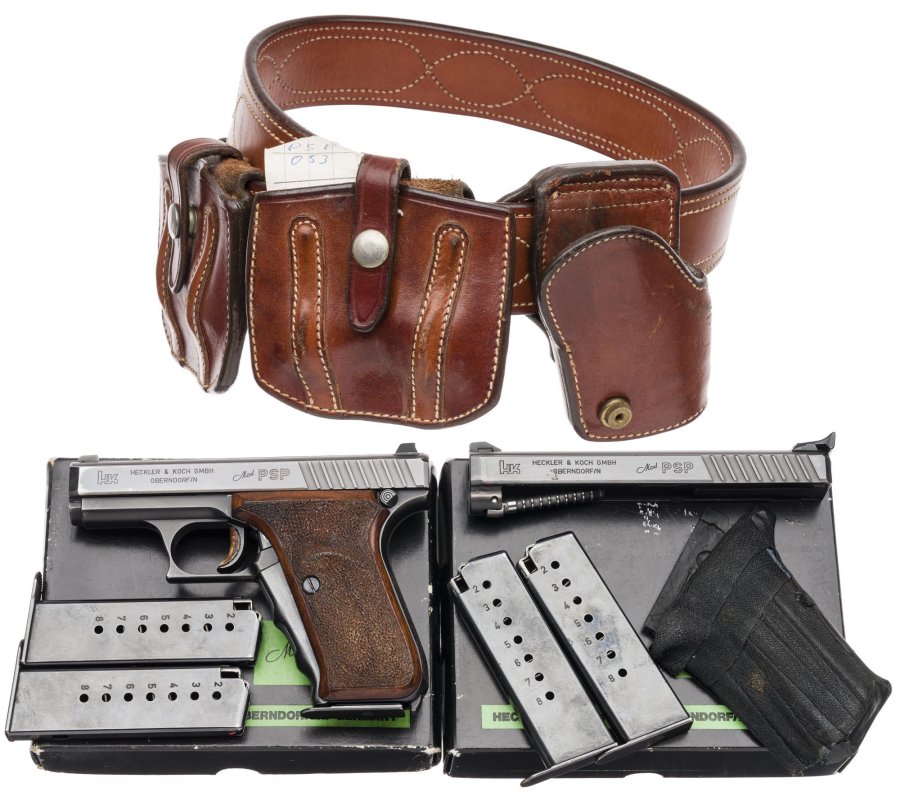
Comeback as a collector's item: HK PSP and P7
With the introduction of the P7, the original model designation PSP increasingly faded into the background – albeit more slowly than one would expect. Initially, both designations can be found on operating instructions, and the pictures show both weapons in a mix. With the start of series production of the P7, the PSP ultimately became superfluous. The guns previously used for carrying tests at various police stations no longer corresponded to the current design status. Anything that does not remain in the police authorities' sample collections will be returned to the manufacturer, overhauled there and then sold via specialist dealers. Some guns are probably also sold directly to end customers – Heckler & Koch does not always make a clear distinction between PSP and P7. A customer who enquires about a discounted purchase option for a former demonstration P7 is ultimately sold a PSP. Meanwhile, a collector scene had already developed in the early 1980s, sometimes paying outrageous sums for certain guns. Special numbers changed hands for up to 10,000 marks during this period. At the time, this was roughly the equivalent value of a basic VW Golf. After years in which the former test guns were rather quiet, today there is once again a trend towards coveted collector's items.



